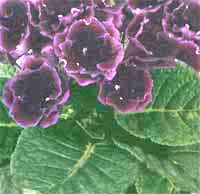Gloxinia (syningia) / gloxinia (sinningia)
Refers to the family gesnerievyh. Fatherland - the tropics of America.
General description : This luxurious ornamental flowering plant is difficult for a beginner florist, usually it is bought in stores already in the flowering stage. For indoor breeding, varieties obtained from a pair of natural species are used: Gloxinia regina (Gloxinia royal) and Gloxinia speciosa (Gloxinia beautiful). The leaves are glaucinia broadly oval, in Gloxinia royal pubescent, with a silvery tinge on the upper side and with a reddish on the back.
The stems are thickened. Flowers of bell-shaped form are located on long peduncles. Variants of colors are very diverse. They can be drooping or directed upward, flapping or not in any way double, with smooth or knuckled edges of the bending of the petals. The colors are scarlet with a snow-white margin, purple with a snow-white margin, snow-white, pink with purple specks, etc. With good care, gloxinia blossoms from spring to autumn. For the period of inactivity, the entire terrestrial portion of the plant dies.
Humidity: Adores high humidity during flowering, but does not tolerate spraying. Humidity of the atmosphere is maintained by placing pots on a pallet with pebbles or expanded clay, which is continuously moistened.
Temperature regimen : During the growth period, moderate, in winter the tubers are stored at a temperature of 10 -12 ° C.
Soil : Proper benign drainage is required. Soil with weakly acid reaction (pH = 5.5 - 6.5).
Recommended soil mixture: 2 elements of leaf land, 1 share of peat and 1 share of sand.
During the flowering period, one needs a fertilizer once a week with liquid complex fertilizers for flowering plants.
Breeding : Seeds and crushing tubers in spring or leaf cuttings in summer.
Transplantation : In the spring, annually, but the size of the pot does not multiply, before it becomes tight. The root system is superficial, so the pot must be wide, but not deep at all. Tubers during the transplant deepen only half.
Pests : It is affected by whiteflies, mealy worms (covered with white cotton woolly fluff), thrips (grayish spots appear on the leaves), aphids (they form sticky excretions on shoot tips, buds).
In these cases, the plant must be sprayed with solutions up to a full cure
Insecticides (actinic, decis, phytoverm, etc.)

Gloxinia gloxinia regina
Gloxinia beautiful Gloxinia speciosa


Comments
Commenting on, remember that the content and tone of your message can hurt the feelings of real people, show respect and tolerance to your interlocutors even if you do not share their opinion, your behavior in the conditions of freedom of expression and anonymity provided by the Internet, changes Not only virtual, but also the real world. All comments are hidden from the index, spam is controlled.